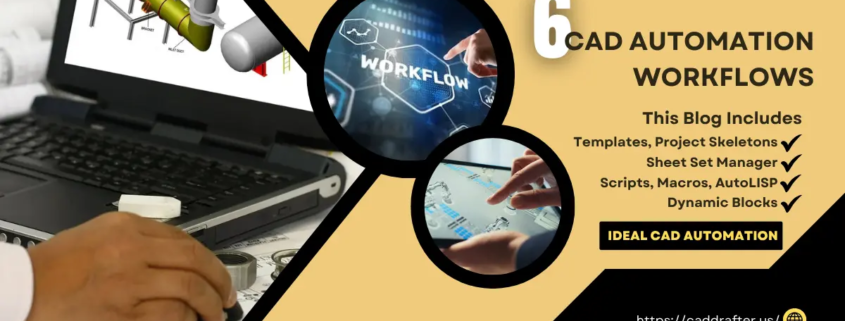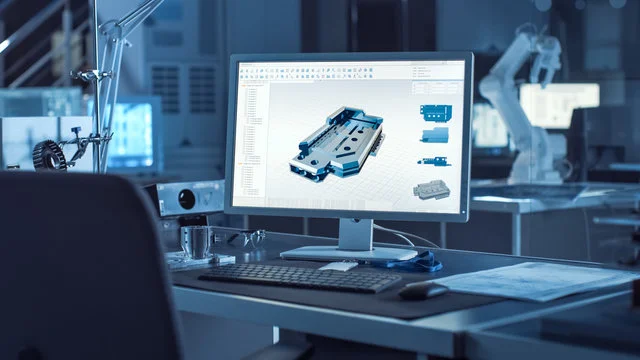6 Time-Saving CAD Automation Workflows Every Construction Drafter Should Know
Picture this. It’s midnight. The office is quiet, the fluorescent light hums, and you’re still wrestling with title blocks. Your mouse hand aches. The clock doesn’t care.
Now, imagine if your computer finished those repetitive edits for you. Not tomorrow. Not next week. Right now. That’s the magic of CAD automation.
The giants (Autodesk, Revit, Dynamo, and a handful of clever CAD vendors) built more than design tools. They built entire ecosystems where scripts, macros, and batch commands can think for you. Not creatively, of course. Just efficiently.
CAD automation workflows are structured sets of commands or scripts in design software. They handle repetitive drafting steps automatically to improve speed and accuracy.
This means you feed the system your standards once, and it starts doing the work you hate. It builds sheets, renames layers, checks lineweights, and even plots entire drawing sets while you refill your coffee. Automation doesn’t replace skill. It amplifies it.
Here’s the simple truth. You don’t need more hours in the day. You need your CAD tools to behave like a well-trained assistant. This blog will streamline 6 CAD automation workflows that help save time extensively.
What You’ll Save With CAD Automation Workflows
Most drafters lose hours on tasks that software can finish before lunch. CAD automation doesn’t just make things faster. It gives you back your focus. The difference shows up at the end of every week. That’s when you realize you finished the same workload without the caffeine jitters.
Here’s what you can expect once your workflows kick in:
Batch plotting: what used to take two hours for a full sheet set can drop to fifteen minutes.
Title block updates: minutes instead of half a morning. The script runs through every drawing, never missing a field.
XRef management: reloads, paths, and cleanup? All automated. Save around thirty minutes for each large project.
Dynamic blocks: tweak once, apply everywhere. It’s like cloning efficiency. Expect up to a 50% cut in revision time.
Sheet Set creation: one click builds an entire project skeleton. What took a day now fits inside a coffee break.
Data extraction: automatic schedules and quantity lists replace manual counting. Easily an hour or two back per set.
Revit Dynamo scripts: batch parameter updates that used to take half a day now run in seconds.
Why Automation Matters for Construction Drafters
Have you ever fixed something in one drawing, then realized ten others have the same mistake? It’s frustrating. It feels like walking in circles. Repetitive tasks kill momentum. Adjust a title block. Change the revision number. Plot a full set. Again. Always again. Your brain tunes out after a point. Mistakes slip in.
Automation helps silent the noise. You set up a rule once. The machine follows it exactly next time. No second-guessing. No tired eyes overlooking a misaligned border. Also: consistency matters. If every sheet looks the same, there are fewer questions on the project site. If every title block is right, fewer back-and-forth emails. Saving time isn’t the only win. Reduced rework is huge.
One small fix applied everywhere saves hours. Maybe more. Because manual fixes stack up. One after another. You might feel freer, too. Not tied to the screen all night. Less grunt work. More design. More solving real problems. More pride in work that’s clean and correct.
How to Use This Guide
Take this guide like a toolbox tossed on your desk. You don’t need to study it line by line. Just open it, grab what looks useful, and get to work.
Some people start big. Others dip a toe in. There’s no right way. What matters is trying something that makes your day easier.
- Start small. Pick one workflow that sounds interesting. I suggest a quick script. Something that fixes sheet titles.
- Play with it. Run it once. Watch what happens. If it breaks, no big deal. Tweak and try again. That’s how everyone learns.
- Move at your own pace. When one idea sticks, add another. Then another. The speed doesn’t matter; the habit does.
- Jump around. You don’t have to follow the order. Skip the boring stuff. Read the parts that make sense for your projects.
- Customize everything. Change names, commands, whatever helps it fit the way you work.
You’ll know it’s working when you stop thinking about time. The scripts run, the files behave, and you’re free to think about the design instead of the process. That’s the whole point.
Workflow 1: Master Templates and Project Skeletons
You know the moment when someone sends you a drawing and you realize their layer names don’t match yours? Or the title block is off-center? That’s the kind of inconsistency that drags a project down. The chaos begins with missing standards.
A good template is your safety net. One place you lock in standards so no one has to reinvent them.
The Problem
- Every new drawing means setting up layers, styles, border layouts… again.
- Someone might use “Wall-1” while you use “Wall_A” — chaos ensues.
- Title blocks get tweaked incorrectly. Fonts or borders shift.
- Plot settings differ from one sheet to the next.
- New team members struggle to match your style, because you never documented it.
When you start a project without a skeleton, you waste time in cleanup. You spend your energy policing drawings. You introduce errors.
The Automation Approach
Here’s the fix: build a project skeleton template and use it every time.
- For AutoCAD: make a DWT file (template) with all your default settings
- For Revit: use an RTE (template) that includes your annotation families, view templates, title blocks
- For Civil 3D: set up default surface styles, pipe styles, alignments, etc.
- Preload layers, linetypes, text styles, dimension styles
- Insert a base border and title block in paper space
- Create view templates and named views so you don’t redraw camera settings
Once your skeleton is there, new drawings begin with the same foundation.
Tools Involved
- AutoCAD template (.dwt) environment
- Revit project template (RTE)
- Civil 3D project template environment
- Layer manager, style manager, view/template systems within those apps
These are native tools you already own. The key is how you configure them.
The Real Result
Once set, this skeleton can save 30 to 60 minutes per new project (or more). You open a fresh drawing. Everything’s there. You don’t waste time recreating the base.
You gain consistency. Someone else joins your project and doesn’t need ten orientation calls. You reduce needless errors, misnamed layers, missing borders, and mismatched plot styles.
Over weeks, those half hours become days saved. And your team starts drafting on the same foundation, not fighting inconsistent setups.
Workflow 2: Sheet Set Manager Automation
You know that feeling when you’re stuck naming sheet after sheet, wondering why this part of drafting still feels like 1998? Yeah. Everyone’s been there. You copy layouts, rename them, fix titles, forget one, fix it again. It’s slow, boring, and just waiting for a mistake.
Now picture this instead: you hit one button, and AutoCAD builds your sheets, names them, fills in the title blocks, and lines everything up for you. That’s Sheet Set Manager doing what it’s actually meant to do.
What Usually Goes Wrong
- Someone renames layouts differently on each project.
- Title blocks don’t match.
- Sheet numbers skip or duplicate.
- Publishing takes forever because you’re opening each sheet by hand.
It’s not just tedious, it’s risky. One wrong name in the middle of a set can throw everything off.
How Automation Fixes It
Sheet Set Manager (SSM) can create order from that chaos. It works best when you feed it good data. Think of it like giving it a grocery list before heading to the store.
Here’s the idea:
- Make a CSV list of your sheets: sheet number, name, title.
- Use a simple macro or LISP script to import that list.
- SSM then builds every sheet in one go, all linked to your master title block.
- The title block fields (like sheet name, number, or revision) pull info straight from the sheet set data.
- You don’t touch them again. They stay synced automatically.
When it’s time to issue drawings, skip the manual plotting. Select your sheet set and click Publish. The whole project drops into a neat PDF package while you grab a coffee.
Quick Setup Guide
- Start a new sheet set. Use your firm’s template as the base.
- Add custom fields. Include project name, discipline, drawn by, checked by.
- Connect the title block. Link those fields to attributes so data flows both ways.
- Import your sheet list. CSV or Excel works fine.
- Test a few. Check numbering, file paths, and output folders.
- Batch publish. Let SSM handle it while you focus on actual design.
Tools That Help
- AutoCAD (any version with SSM)
- Excel or Google Sheets for CSV creation
- Optional: AutoLISP scripts, ScriptPro, or any lightweight macro tool
The Payoff
After the setup, adding a hundred sheets takes minutes, not hours. Every sheet looks right, the numbering stays consistent, and you never lose another evening to plotting.
You’ll save at least an hour on larger projects, sometimes more. The best part isn’t just the time, it’s the peace of mind. Your drawings finally feel organized, predictable, and professional without you babysitting them.
Workflow 3: Batch Plotting and Publishing
Plotting can chew through an entire afternoon if you let it. You open one file, set the layout, check the page setup, and plot to PDF. Then you do it again. And again. By the tenth drawing, you start wondering why this part of the job still isn’t automatic.
It actually can be!
The Problem
Manual plotting is one of those hidden time traps.
- You change paper size by hand.
- You double-check plot styles.
- You forget one sheet and have to run the whole thing again.
- Someone else overwrites a PDF because filenames aren’t consistent.
It’s boring and risky. The more drawings, the greater the chance that something goes sideways.
How Automation Fixes It
AutoCAD has tools built in that most people barely touch: Publish, Batch Plot, and of course, Sheet Set Manager. These handle the grunt work once you set them up right.
Here’s how you make it painless:
- Build page setups for every sheet size you use: A1, A2, A3, etc.
- Store those setups in your master template (DWT).
- Open Publish and add all your layouts.
- Choose your page setup, output folder, and PDF naming rule once.
- Save that list as a DSS (drawing set) so next time it’s just load and go.
- If you already use Sheet Set Manager, link it directly to your publish setup.
The next time you need a full issue set, hit Publish, grab coffee, and come back to a folder full of perfect PDFs.
The Result
You can turn hours of clicking into minutes. No missing sheets, no wrong scales, no mismatched plot styles. Every page looks right because you only had to check it once.
Even better, when deadlines hit and you need a new revision set, you just re-publish. The process doesn’t change. The results stay clean, consistent, and fast.
Workflow 4: Scripts, Macros, AutoLISP, and Action Recorder
Now for the fun part, the tiny bits of code that make the computer do the boring stuff for you. You don’t need to be a programmer. You just need to be tired of doing the same five clicks fifty times a day.
The Problem
Every drafter has a few repetitive tasks that never end.
- Renaming layers.
- Updating title blocks.
- Purging old styles.
You do it over and over, across dozens of files. It’s mind-numbing.
The Automation Approach
That’s where scripts, macros, and AutoLISP come in. These tools repeat commands for you, exactly how you’d do them — only faster and without complaining.
You’ve got options:
- Scripts (.scr): simple text files that run a series of commands line by line.
- AutoLISP: for more complex stuff like looping through folders or updating attributes in bulk.
- Action Recorder: built right into AutoCAD, it records your clicks and lets you play them back anytime.
How to Set It Up
- Start with a small task, like renaming layers or cleaning files.
- Record the steps using Action Recorder or write them in a simple script.
- Test it on a copy of a drawing first.
- When it works, assign it to a custom button or hotkey.
- Apply it to every file in a folder using ScriptPro or a batch processor.
You could tweak it to update project data, dates, or revision info automatically across all sheets.
The Result
After a few tries, you’ll start building your own mini-tools. You’ll wonder how you ever worked without them.
Scripts and macros don’t just save time, they keep your process clean. The same action, the same result, every time. And once it’s set, it runs while you’re already on to the next task.
Let Us Automate Your CAD Design Projects
Workflow 5: Dynamic Blocks and Centralized Libraries
You can always spot the old drawings. Rows of copied symbols, each slightly off from the next. Someone stretched one. Another rotated it a bit too far. By the time revisions roll in, none of them match. That’s what happens when every block lives its own life.
The Problem
- You edit the same object a dozen times in different files.
- Components lose consistency. That means one outlet symbol is bigger, and another has the wrong text.
- Revisions mean hunting through hundreds of drawings just to fix one thing.
The Automation Approach
Dynamic Blocks fix that chaos. You build one smart block that can stretch, flip, or change visibility without needing separate versions. One block, many forms.
Here’s how it works:
- Define parameters, length, angle, visibility, rotation, lookup.
- Add actions to those parameters so the block reacts when you grip or click it.
- Include attributes for labels, counts, or IDs.
- Save everything to a central library folder that your team uses as a single source of truth.
When someone updates a block definition in that library, it filters down. Every drawing using it can sync to the new version.
Practical Setup
- Open the Block Editor.
- Add parameters (stretch, visibility, lookup).
- Link them to actions. Maybe a stretch handle or a toggle for alternate views.
- Test it before saving.
- Store it in your shared block library.
- Set that library path under Options > Files > Support File Search Path.
After that, everyone pulls from the same smart library.
The Result
- Fewer duplicate blocks cluttering folders.
- Components that adjust on the fly.
- Updates ripple through projects automatically.
- Consistent graphics and sizes every time.
It’s cleaner drafting. Less fixing, more drawing. Once you get used to smart blocks, static ones feel like typewriters.
Workflow 6: Automatic Attribute Extraction and Data Linking
Data lives everywhere inside your drawings. Layer names, block attributes, dimensions, and material tags, all hiding in plain sight. And yet, many teams still type it out by hand into Excel. It’s slow. And it’s begging for typos.
The Problem
- Manual data take-offs and quantity schedules.
- Re-keying info into spreadsheets.
- Outdated numbers when drawings change.
- Double work that breaks consistency between drawings and reports.
You tweak a note in CAD, but your Excel file still shows last week’s data. That gap causes bad estimates and worse surprises.
The Automation Approach
Instead of typing it again, extract it.
AutoCAD’s Data Extraction tool (and Revit’s built-in schedules) can grab all that information straight from your model.
How it works:
- Select the drawing or folder you want to scan.
- Choose what to extract. It could be block attributes, layers, lengths, or object data.
- AutoCAD builds a table and exports it directly to Excel or CSV.
- Link that data into your cost sheet or procurement tracker.
If you link it dynamically, updates in the drawing are reflected in the spreadsheet. No more manual syncing.
Steps to Set It Up
- Run the DATAEXTRACTION command.
- Pick your drawings.
- Choose object types or attributes to extract.
- Format your table (columns, headers, units).
- Save the template for reuse next time.
- Export to Excel or link it live.
Revit users can achieve the same thing with Schedules or Shared Parameters. Next, export those schedules to Excel.
The Result
- Live, accurate quantity data.
- Instant cost updates when drawings change.
- No double entry or manual counting.
- Reliable project reporting that matches your latest design.
The Key Takeaway
Automation isn’t about replacing drafters. It’s about letting people breathe again.
The software already knows how to copy, rename, stretch, and plot. So, why keep doing it by hand?
Each workflow in this guide chips away at the small, invisible tasks that eat up your week. Ten minutes here, twenty there. Add them up and you’ve got entire days back every month. That’s time you could spend on design coordination, solving clashes, or catching the kind of detail that actually matters.
It’s not one big leap either. You start small. Maybe a script. Maybe a sheet set template. Then another workflow. Slowly, the whole process begins to run smoother.
The best part is that once your team sees it working, the habit spreads. People share templates. Someone improves a script. Standards tighten without a meeting about standards.
Tools like AutoCAD, Revit, and Civil 3D already have these capabilities waiting in the background. The trick is using them on purpose, not by accident.
So take one workflow from this list and try it today. Don’t chase perfection, just get it running.
The time you save will prove the point faster than any blog post ever could.
FAQs
What is CAD automation really about?
It’s just a way to stop doing the same small steps over and over. You make the computer handle them instead. Things like naming layers, plotting sheets, updating notes, or filling title blocks can all run automatically once they’re set up. You still make the decisions, the software just repeats them faster and without forgetting.
Is it complicated to learn?
Not at all. Most of it lives inside the programs already. You can click around and find tools that do half the work for you. A few scripts can help later, but you don’t need to know code at the start. Learn one small trick, use it, then move to another.
What programs can actually do this?
AutoCAD does it. Revit does it. Civil 3D too. Pretty much anything from Autodesk has automation built in somewhere. Even free tools have some kind of batch or template feature now. If your software can repeat actions, it can be automated a little.
How much time does CAD automation save?
Hard to put a number on it. Some people save an hour here, others save a full day each week. It depends on how many drawings you touch. Once templates and scripts are in place, setup time drops fast. You’ll notice it after a few projects.
Does CAD automation workflows help with accuracy?
Yes. Repetition is where most mistakes happen. If a machine repeats the steps, it does them the same every time. That means no missed title block info, no wrong plot scales, and no forgotten layers. Less fixing later on.
Where should someone start in CAD automation workflows?
Begin with your templates. Make them solid. Add standard text styles, borders, layers, and plot setups. Then move to Sheet Set Manager or Batch Plot. Once you’re comfortable, try recording a small macro. Keep it simple and see how it works.
Is it safe to use on active jobs?
It’s safe if you test first. Always run your new setup on a copy of a drawing. If it looks right, use it for real. Backups are your friend.
Why do more drafters care about automation now?
Because the work keeps piling up and the deadlines don’t move. Automation helps people stay on schedule without losing quality. It’s not about replacing drafters. It’s about getting time back to focus on design instead of doing the same command fifty times.






